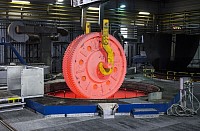Increase LifeSpan Of Gears!
Heat Treatment: CARBURIZING
Carburizing stands as a meticulous surface heat treatment technique, intricately weaving carbon into iron or steel during the heating process. The overarching goal is to fortify the metal, rendering it not only harder but also imbued with increased strength.
This transformative process finds its application in a spectrum of alloys, including 3310, 4320, 4820, 8620, and 18CrNiMon7, among others.
On a parallel front, the domain of Induction Hardening unfolds as a distinctive facet of surface heat treatment. In this method, a metal component undergoes a mesmerizing dance with induction heating before plunging into the depths of quenching.
Meanwhile, through hardening elevates carbon and alloy steels, such as the stalwarts 1045, 4130, 4140, and 4330v, to hardness ranges spanning 200-400 BHN, providing a robust foundation for diverse industrial applications.
Delving into the intricacies of Induction Hardening, a CNC gear induction hardening machine takes center stage. Its prowess extends to gears boasting dimensions of up to 5.0m in diameter and a face width of 0.75m.
Likewise, it extends its influence to shafts, reaching lengths of 3.0m with a face width of 1.25m.
To ensure the quality and reliability of these heat-treated components, nondestructive ultrasonic case depth testing becomes a hallmark of the process.
Carburizing and hardening enter the scene as a dynamic duo, with newly installed pit carburizing furnaces assuming a prominent role. These furnaces come in varying dimensions, offering versatility in accommodating different sizes of components.
The array of options, from pits with a diameter of 1.0m and a depth of 1.5m to those with dimensions of 2.0m in diameter and 4.5m in depth, ensures a tailored approach to metallurgical enhancement.
Gears and shafts, ranging from a modest 100 lbs. to a substantial 50,000 lbs., find their transformative journey within these hallowed walls, emerging fortified and resilient.
Carburizing gears greatly extends their lifespan by boosting durability and resistance to wear. This, in turn, reduces the frequency of gear replacements, minimizing downtime and enhancing overall operational efficiency.
The array of options, from pits with a diameter of 1.0m and a depth of 1.5m to those with dimensions of 2.0m in diameter and 4.5m in depth, ensures a tailored approach to metallurgical enhancement. The saga of metallurgical prowess extends to a dedicated heat treat facility.
Carburized gears exhibit enhanced wear resistance and fatigue strength, resulting in fewer maintenance needs and repairs. This reduction in breakdowns and failures not only cuts down on maintenance costs but also allows resources to be redirected to other essential production areas.

